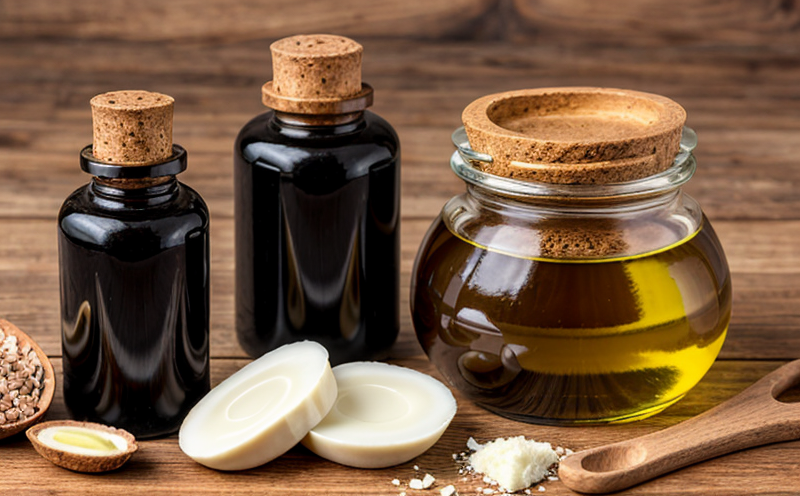EN 14105 Free and Total Glycerol Determination in Oils
The European Standard EN 14105 provides a comprehensive method for determining both free glycerol and total glycerol content in vegetable oils, animal fats, and other lipid-rich products. This service is crucial for ensuring product quality, compliance with international standards, and maintaining the integrity of food and feed products.
The determination of free and total glycerol levels helps manufacturers meet regulatory requirements set by various national and international organizations such as the European Commission (EC), the Food and Agriculture Organization (FAO), and the World Health Organization (WHO). Accurate measurement ensures that products do not exceed safe limits, which is particularly important for health considerations.
Free glycerol refers to the glycerol present in triglycerides that has been released during processing or breakdown. Total glycerol includes both free glycerol and glycerol found within intact triglycerides. The standard specifies precise methods for sampling, preparation of samples, and analysis using spectroscopic techniques like near-infrared (NIR) spectrometry.
The process involves several key steps: sample collection from the production environment or storage facilities, homogenization to ensure uniformity, filtration, and subsequent extraction of glycerol. Extraction can be achieved through chemical methods such as acid hydrolysis followed by gravimetric determination or titrimetric analysis. This method ensures accurate measurement of both free and total glycerol content.
For accurate results, it is essential to follow the standard procedures meticulously. Any deviation from these protocols could lead to inaccurate measurements, which may have significant implications for product safety and regulatory compliance. Compliance with EN 14105 not only ensures that products meet legal requirements but also enhances consumer confidence in the quality of food and feed products.
The importance of this testing cannot be overstated. It plays a vital role in the production, processing, storage, and distribution stages of lipid-rich products. By adhering to these standards, manufacturers can ensure consistency in product quality, which is critical for maintaining brand reputation and customer satisfaction.
Why It Matters
The accurate determination of free and total glycerol levels in oils and fats is fundamental for several reasons. First and foremost, it ensures that products comply with international standards such as EN 14105. This compliance is crucial because it protects consumers from potential health risks associated with excessive glycerol content.
Secondly, accurate testing helps manufacturers maintain product quality throughout the supply chain. Variations in glycerol levels can affect various properties of fats and oils, such as stability, texture, and flavor. By monitoring these parameters closely, companies can ensure that their products meet the expected specifications at every stage of production.
Thirdly, this testing is vital for regulatory compliance. Many countries have strict regulations regarding the maximum permissible levels of glycerol in food and feed products. Non-compliance with these regulations can result in severe penalties, including fines, product recalls, and even legal action. Therefore, reliable and accurate testing methods are essential to avoid such pitfalls.
Lastly, this testing supports research and development activities aimed at improving the quality of fats and oils. By understanding how different factors influence glycerol levels, researchers can develop better production processes and formulations that enhance product performance and safety.
International Acceptance and Recognition
EN 14105 enjoys widespread acceptance across Europe and is increasingly being adopted globally. Its rigorous methodology ensures consistent results across different laboratories, making it a trusted standard for the industry.
The European Commission (EC) has recognized EN 14105 as an official reference method for determining free and total glycerol in oils and fats. This recognition underscores its reliability and accuracy, which are essential attributes for any analytical technique used in food safety and quality assurance.
Other international bodies such as the Food and Agriculture Organization (FAO) and the World Health Organization (WHO) also recommend using EN 14105 when assessing glycerol content. This recommendation is based on the standard’s ability to provide accurate, reproducible results that can be relied upon by regulatory authorities worldwide.
The growing adoption of this method reflects its importance in ensuring product safety and quality across borders. As international trade continues to expand, standards like EN 14105 play a critical role in facilitating seamless exchanges between countries with differing regulatory frameworks.
Moreover, the use of internationally recognized methods such as EN 14105 enhances trust among stakeholders involved in the food and feed industry. Consumers can be assured that products conform to stringent quality control measures, while manufacturers benefit from reduced risk of non-compliance issues.
Use Cases and Application Examples
The application of EN 14105 is extensive, covering various sectors within the food and feed industry. One common use case involves monitoring glycerol levels in biodiesel production processes. Biodiesel manufacturers rely on this standard to ensure that their final products meet strict quality criteria set forth by regulatory bodies.
In another example, EN 14105 is utilized during the refining of vegetable oils. This process aims to remove impurities and improve the oil’s color, flavor, and stability. By accurately measuring glycerol content before and after refining, processors can optimize their processes for maximum efficiency.
Agricultural feed manufacturers also use this standard when formulating products intended for livestock consumption. Ensuring that feed meets specific nutritional requirements is critical for promoting animal health and welfare. Accurate determination of free and total glycerol helps meet these goals by providing precise information about the lipid content in feeds.
For ingredient suppliers, EN 14105 serves as a valuable tool for quality control purposes. By regularly testing incoming raw materials against this standard, companies can ensure consistency and reliability across batches of product.
In summary, EN 14105 finds application not only in production environments but also throughout the supply chain where accurate measurement of glycerol content is necessary to maintain high standards of quality and safety.





